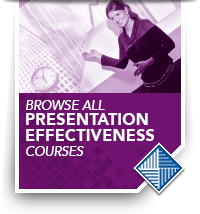 Over the 15 years I've trained and presented online, I've seen and learned some very interesting things when it comes to communicating and engaging a group of participants while using a webcam. I’m also a member of a dispersed team that meets virtually far more often than not. While I've seen webcams work, I've mostly seen them underwhelm and be an unnecessary use of bandwidth – but not always. Read on for 4 things you need to know about using webcams.
Over the 15 years I've trained and presented online, I've seen and learned some very interesting things when it comes to communicating and engaging a group of participants while using a webcam. I’m also a member of a dispersed team that meets virtually far more often than not. While I've seen webcams work, I've mostly seen them underwhelm and be an unnecessary use of bandwidth – but not always. Read on for 4 things you need to know about using webcams.
1. Engagement is in the eye (and ear!) of the beholder.
Each participant will have their own opinion on what will engage them, related to that topic, on that day, in that platform or space, and with that trainer/presenter. Online training industry experts speak of participants having a moment of excitement when they realize a webcam is being used, but the interest often fades. Turning it on at key points can add context and interaction, without taking up bandwith or using a tool just because you can.
My unofficial webcam tests as an online trainer: Every time I present a webinar, I ask participants who come early if they would like to say hello on their webcams. In the last year, I delivered 3-6 webinars a month. I can recall exactly two times when online learning participants agreed to it. Most people did not have webcams and those who did, preferred to not be seen in a training with other people they did not know.
Additionally, I conducted a test where I planned to stay on the webcam the entire duration of a one hour webinar. I memorized my one hour talk's key points and interactive moments, worked hard to look directly into the camera, warned participants I'd be looking at the chat at certain times instead of directly into the camera, and did my best to "pretend" I was looking at them, since I could not see them, when they were responding to questions and comments made during the session. After 20 minutes they unanimously agreed that although they loved seeing me introduce myself on camera, and that they thought I was nice looking (!!), they respectfully asked me to turn it off as it was distracting them from the topic of the program. I couldn't have been more pleased to turn it off so I could finally get to focus on them and their responses to the content and interaction rather than whether or not I was looking into the camera properly.

2. Use the right tool for the job. In training design this means we need to use the best feature to meet the meeting objective.
Does the webcam support and drive the objective of the meeting and help the participant better understand what is being communicated? If the answer is yes, then use it. If the answer is I don't know, then don't use it until you find out. The important thing is to be honest about this. If a person needs to receive critical information from the presenter’s face as the speaker looks into a webcam, then it can work. In these cases, the trainer or presenter needs to be a great performer, modeling themselves after those who work in broadcasting. The ability to replicate "looking" at others can only occur if everyone is on a webcam together. See my point next on why meetings are different from online learning events.
Great Webcam Training Example: A perfect example of the webcam being used properly to meet a learning objective was when the IT director taught my team how to use our new VOIP phones. He used the webcam to zoom in on the buttons on the actual phone. It was useful and more engaging and clear than a screen shot could have ever been. It was like he was at our desks, all of us at the same time. A brilliant use of the platform's tool!
Virtual Meetings that Engage (1-hour live online webinar)
Learn how to energize your next online meeting. This webinar will help identify what's unique about running an online meeting and what's needed to make it an interactive experience.
3. Meetings with people who already know each other are different than public learning or client/prospect events.
The simple fact that the participants know each other, or at least know the "culture" of a company and work together already, even if they don't know each other personally, is a game changer. People are not as nervous to be seen on camera when a relationship or common experience already exists. In these “familial” cases, the novelty of the webcam feature takes over, and the pleasantness of seeing a colleague one hasn't seen in a while translates into a "nice feeling." Also important to note is that ALL participants usually come on webcam together in this case, thus taking the focus off any one person as each person looks and responds to each other instead.
In recent online sales presentations, we have used the webcam to "lighten up" the tone of the call. We have literally seen people become more at ease (via their non-verbal body language) when talking to each other as soon as they see each other on camera. People smile and then seem to really "open up." But every time, after we have all said our hellos on the webcams, people quickly want to "get back to business" and turn off the cameras so they can focus. For these calls, the cameras become distracting once the introductions have been conducted.
 Dispersed Workforce Insights Paper
Dispersed Workforce Insights Paper Tips for managers and employees negotiating the virtual workplace. Make your dispersed teams your greatest asset.
4. A learning event or sales call is not supposed to be about the presenter, it is supposed to about the participant.
Seeing a presenter on a webcam during a live online training event or webinar tends to make it about the person delivering it and not about me, the attendee. I then expect a performance that entertains or inspires me. I get to "see" that person, that personality, to be engaged by that performance. I don't necessarily learn something that I myself will do, like use new software, or implement a new process, or try a new technique. And this goes back to Point #1 above: use the right tool for the right job. If I'm in need of learning something that I need to do, use, implement or try (a new skill) then I need to be the one doing, using, implementing and trying while I am on the call or web event.
The Muppet "Beaker" conducted the following webcam experiment. His audience response was "With any luck, I'll never see anything like it again!"
May we all learn from Beaker! Enjoy!
-Kassy
Dale Carnegie Live Online Training
Dale Carnegie breaks the mold of lecture-format webinars! In our sessions, all participants are expected to speak, chat, answer questions and collaborate with peers. It’s 2-way online engagement like you’ve never experienced! View our complete course list.

 The rules of running meetings have changed! Organizations and teams are spread out more than ever. Online, or virtual meetings, save costs; help bring busy, dispersed employees together, and are convenient for everyone.
The rules of running meetings have changed! Organizations and teams are spread out more than ever. Online, or virtual meetings, save costs; help bring busy, dispersed employees together, and are convenient for everyone.


 This article was contributed by
This article was contributed by 



 Researchers tell us we remember 10% percent of what we read, apply 50% of what we see and hear – and retain 90% of what we learn by doing. Today, reading how to do something first is a luxury. Far better and more efficient is training by doing.
Researchers tell us we remember 10% percent of what we read, apply 50% of what we see and hear – and retain 90% of what we learn by doing. Today, reading how to do something first is a luxury. Far better and more efficient is training by doing.
 Over the 15 years I've trained and presented online, I've seen and learned some very interesting things when it comes to communicating and engaging a group of participants while using a webcam. I’m also a member of a dispersed team that meets virtually far more often than not. While I've seen webcams work, I've mostly seen them underwhelm and be an unnecessary use of bandwidth – but not always. Read on for 4 things you need to know about using webcams.
Over the 15 years I've trained and presented online, I've seen and learned some very interesting things when it comes to communicating and engaging a group of participants while using a webcam. I’m also a member of a dispersed team that meets virtually far more often than not. While I've seen webcams work, I've mostly seen them underwhelm and be an unnecessary use of bandwidth – but not always. Read on for 4 things you need to know about using webcams.
 Dispersed Workforce Insights Paper
Dispersed Workforce Insights Paper